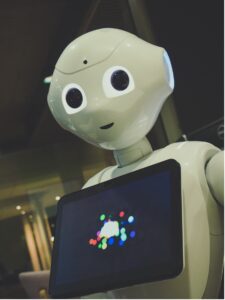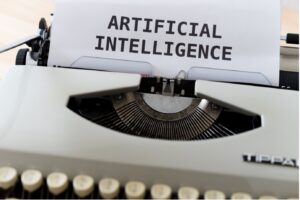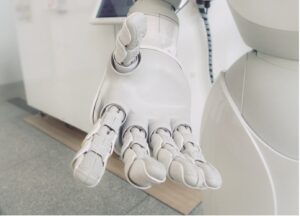Felix Becker, Professorship of Business Administration, in particular of SME Management and Entrepreneurship, University of Siegen.
Contact: felix2.becker@uni-siegen.de
Abstract
Artificial Intelligence is one of the most vivid topics nowadays, both in everyday life as well as in the scientific discourse. While the first steps towards Artificial Intelligence were taken over half a century ago (mainly by information system scholars), the debate has been particularly sparked recently, especially in a research related context. As the 21st century working world is all about technology and, accordingly, digitalization related aspects, Artificial Intelligence is having a rapid growth and is finding its way into many areas of business. It is disrupting the working world in such a way, that it is having a dramatic impact on business models of all types of companies and the way we work in general. Research is also affected by the novel trends of digitalization and the changes that result. This blog post discusses part of this, namely the ways in which Artificial Intelligence is altering research and the corresponding methods, and the new methodological opportunities that are emerging as a result.
Getting started

Photo by Owen Beard on Unsplash
Recently, the general debate about Artificial Intelligence (AI), has been a recurring and highly controversial topic. Whilst the subject has found traction in many areas of modern research, in particular scholars in the context of entrepreneurship and management science are interested in the investigation, applications, and implications for both theory and practice (Chalmers, MacKenzie & Carter, 2020). The wide range of applications and opportunities for entrepreneurs and businesses, as well as the long-term transformations brought by this technology, have led both empiricists and theorists from a variety of research disciplines to address this vibrant topic.
Basically, AI describes the ability of machines to independently imitate intelligent human behavior and in the end derive (in the best case) similar results (McCarthy, 2007). Often, AI operates by leveraging vast amounts of data, also known as big data (Obschonka & Audretsch, 2019). Researchers have increasingly been encouraged to conduct more research in the context of AI, especially in areas such as management and entrepreneurship (Chalmers et al., 2020; George, Haas & Pentland, 2014; Kolbjørnsrud, Amico & Thomas, 2016; Liebregts, Darnihamedani, Postma & Atzmueller, 2019; Obschonka & Audretsch, 2019). The potential impact of AI on multiple sectors of the economy could be a reason that has further fueled the scientific debate (Makridakis, 2017). While the fundamentals of AI stem from information system literature, the multidisciplinary research opportunities that have emerged from this will be emphasized in this blog entry (Obschonka & Audretsch, 2019).
Nowadays, there already is empirical research examining the application of AI in various business areas (Davenport & Ronanki, 2018; Ransbotham, Kiron, Gerbert & Reeves, 2017). Studies of the concrete application fields of AI in the business context are equally diverse, for example, robotics could be used in combination with AI in manufacturing processes (Xiao, Muthu & Kadry, 2020), but also in completely different areas such as portfolio management (Javelosa, 2017) or customer service (Fluss, 2017). With current technology, blue and white collar as well as high-paid workers such as lawyers, managers or even representatives out of the c-suite could be supported in their decision-making processes or to some extent even be replaced by machines (Chui, Manyika & Miremadi, 2015; Grace, Salvatier, Dafoe, Zhang & Evans, 2018). Particularly in the field of executives, the interaction between experts, so-called „quants,“ and „translators“ is becoming increasingly important. While the ‘quants’ achieve the complex results, the ‘translators’ bring them into the real world and apply them to the respective use cases (Davenport & Ronanki, 2018; Pyle & San José, 2015). Some researchers even consider that the application of AI has ushered in the so-called fourth industrial revolution, a new era of labor and the transformation of the way people work in general (Chalmers et al., 2020; Schwab, 2017). Human characteristics, such as emotionality and empathy, will ultimately become more important in business life, while the machine could support and ultimately perform routine tasks (Dewhurst & Willmott, 2014). Existing studies mostly focus on very advanced technological and pioneering countries such as China, Japan, South Korea, and the U.S. (Damioli, Van Roy & Vertesy, 2021).
AI, like previous technological advances, has the potential to disrupt and change entire sectors of the economy (Damioli et al., 2021). Therefore, AI is also more frequently discussed in scientific discourse, especially in the context of innovation (Cockburn, Henderson & Stern, 2019; Van Roy, Vertesy & Damioli, 2020) and entrepreneurship (Chalmers et al., 2020; Obschonka & Audretsch, 2019).
Technological change is considered to be omnipresent and influential in research, moreover, it is even considered as a ‘Grand Challenge’. This blog entry will investigate the impact of AI and the associated methodological opportunities and tools for research. Through the blog entry, I would like to contribute to the exploration of new innovative methods. To this end, I would like to present the possibilities and discuss their opportunities as well as their weaknesses for the analysis of novel data sources, thus contributing to entrepreneurship research. But before we delve deeper into the respective AI and ML applications, we should first distinguish what exactly AI and ML are and how these two terms can be differentiated from one another.
Artificial Intelligence (AI)

Photo by Markus Winkler on Unsplash
As an attentive reader, you are probably asking yourself: ‘What exactly is Artificial Intelligence? And why is everyone talking about it these days?’ Well, AI is a branch of computer science that deals with the simulation of intelligent human behavior. In this sense, computers perform complex tasks through algorithms (such as text and image recognition) that would normally only be attributed to human intelligence. The use of AI has intensified in recent years and has become part of people‘ s everyday lives. Tangible examples of its use are voice assistants such as Siri or Alexa, self-driving cars from Tesla or recommendation systems such as Netflix or Amazon. Likewise, in 2016 AI defeated the world champion for the first time in the very complex Chinese game Go (Borowiec, 2016). From a scientific point of view, however, it is not a field of research that has just emerged. Turing (1950) is considered to be one of the founders of AI, who dealt with topics such as intelligence and machines in combination at a very early stage. The method he developed, the so-called Turing test, is still frequently applied. In principle, the objective of this test is to determine whether a machine has a similar mental capacity as a human being (Turing, 1950). However, due to challenges such as data storage and computing capabilities, the term AI has not been widely adopted and applied in modern business contexts (Schoonhoven, Roelands & Brenna, 2018). According to a WIPO report (2019), innovators and researchers have filed nearly 340,000 AI-related patents and published over 1.6 million scientific papers since the „birth“ of AI in the 1950s.
While possible application fields of AI, both in societal and corporate contexts, are manifold, the scientific discourse still lacks a universal definition of the term (Damioli et al. 2021). Although there is no clear definition of AI yet, researchers are increasingly addressing the issue: ‘Theories of intelligence and the goal of Artificial Intelligence (A.I.) have been the source of much confusion both within the field and among the general public.’ (Monett & Lewis, 2018). Wang (2019) characterizes intelligence as: ‘adaptation with insufficient knowledge and resources.’ Ganesh (2020), from a more practical point of view, describes AI as: ‘[…] a suite of technologies that includes machine learning, computer vision, reasoning, and natural language processing, among others.’ Davenport and Ronanki (2018) classify the utilization of AI into 3 business necessities: gathering information through data analysis, interacting with employees and customers, and optimizing internal processes. WIPO (2019) on the other hand in their report on AI generally categorize their analysis into three areas: AI techniques (e.g., machine learning), functional applications (e.g., NLP, speech processing, robotics) and application fields (industries). While there is still no clarity on the definition, it is expected that in the future AI will be able to draw conclusions and make predictions that may even surpass human intelligence (Obschonka & Audretsch, 2019).
Since the beginning of scientific research on economic growth, it has been established that innovation, and consequently technological progress, has a positive impact on growth (Solow, 1957). Increased overall business production power, driven by innovations like AI, can have multiple impacts on companies. At the core of these are the generation of new innovations as well as patent applications (Bartelsman, Falk, Hagsten & Polder, 2019; WIPO, 2019), reduced uncertainties due to (data-based) automated predictions (Agrawal, Gans & Goldfarb, 2019), and automated operations of existing technologies (Agrawal, McHale & Oettl, 2019). AI is fundamentally perceived as one of, if not the biggest, disruptive technology of recent times (Acemoglu & Restrepo, 2019; Aghion, Jones & Jones, 2019; Cockburn et al., 2019; Trajtenberg, 2018; Craglia et al., 2018). Therefore, companies should not neglect this technology to maintain their competitive advantage (Mahidhar & Davenport, 2018) and strategically incorporate it into their operations (Bughin, 2018).
Machine Learning (ML)

Photo by Possessed Photography on Unsplash
Since the 1990s, researchers and developers have been working intensively on the concept of machine learning (Russell & Norvig, 2010; Witten, Frank, Hall & Pal, 2016). ML is a subfield of AI and can be understood as a collection of mathematical methods and algorithms for pattern recognition. At its core is the development of applications that are capable of learning from (often big) data and improving its accuracy through iterations (KI Revolution, n. d.). ML can, on the one hand, be divided into supervised learning, unsupervised learning, and reinforcement learning. The core of all three forms is to learn from data to be able to make predictions and thus support decision making (KI Revolution, n. d.). ML has given rise to another subtype: deep learning. Deep learning is an attempt to imitate human brain activity through neural networks to achieve similar results (Davenport & Ronanki, 2018). Both approaches open up completely new methodological avenues for scientific research, as they enable the analysis of unstructured and large data sets (Pyle & San José, 2015). For reasons of limited space, the topic of deep learning will not be dealt with in greater depth in the remainder of this blog entry. However, the potential that this technology can provide by itself is so huge that at least a brief mention of it is necessary.
Pyle and San José (2015) on the other hand break down the ML process into three subparts: description, prediction, and prescription. This division of ML becomes particularly interesting in a contextual distinction of company types. While the description stage, the phase of data collection and database construction, has already been completed by large companies, most of them are now in the prediction phase (Pyle & San José, 2015). SMEs still need to catch up with this progress, as it is often the case with advanced technologies, because they tend to lack resources, such as monetary capacity, for boosting innovativeness (Aldrich & Auster, 1986; Hausman, 2005; Vasilescu, 2014). Furthermore, SMEs are usually more risk averse, particularly in terms of the implementation of digital technologies (Ahmad, Bosua & Scheepers, 2014; Taylor & Murphy, 2004), since they frequently fail to grasp the opportunities that these technologies entail. They also appear to be less efficient in adopting digital technologies compared to large companies (Bajwa et al., 2008; Damanpour, 1991; Harland, Caldwell, Powell & Zheng, 2007).
Big Data

Photo by Joshua Sortino on Unsplash
Big data is a very common buzzword in the context of AI. Agrawal, Gans and Goldfarb (2018) refer to it as ‘the new oil’ of AI. Basically, big data are very large amounts of data which are often unstructured and incomprehensible to humans due to their mere size. AI, and ML approaches in particular, can be used to evaluate and analyze these large volumes of data. One special characteristic thereby is that it does not depend on whether the data is in numerical, character or word form. Over the course of time, various approaches and methods have been developed to deal with such large amounts of data. Likewise, there has been a shift in terms of understanding intelligent machine behavior: ‘In 1987, a computer was considered ‘intelligent’ because it beat the world’s highest ranked chess player. Now, a computer will be considered intelligent if it can drive a car; or because it generates a response based on your facial expression. Intelligence becomes a moving target defined by tasks like perception, pattern recognition, language processing or prediction.’ (Ganesh, 2020).
Throughout this blog entry, I would like to take you a little further along on the journey into this topic, because, as you will see from some examples, we all already have, even maybe unconsciously, touchpoints with this subject, both in our personal as well as professional lives. For this reason, I would like to briefly sketch out for you the new avenues and opportunities that this technology has in store for all of us, but especially in an academic context (Lévesque, Obschonka, & Nambisan, 2020). Many of the application areas of AI and ML can be especially relevant for researchers and their own projects and thus offer opportunities to further advance and boost their own research.
In the remainder of this blog post, there are a few helpful opportunities and concrete tools that lay a foundation for working with AI and ML in a research context.
Possible applications of AI in research: Data Generation

Photo by Ales Nesetril on Unsplash
To give you a practical example of one of my ongoing projects, one of the ML techniques I work with in my research is Natural Language Processing (NLP). The data basis for this research project is website text data. Therefore, I use different techniques and tools to scrape the data in a first step and prepare it for later analysis. In the following I would like to make a short excursion on the topic of webscraping and thus introduce you as a reader to the subject and demonstrate the possibilities of the latter.
What is webscraping?
Webscraping is the automated extraction of (text) data from (corporate) websites. Via HTML code (Hypertext Markup Language (HTML) – the programming language on which websites are based on), the content of a website can be extracted. Basically, in the first step it does not matter what kind of website it is (database, social media platform, „conventional“ corporate website). The structure of a website and its content are identical in most cases (e.g. <h1> = header 1, <p> = text, etc.). By utilizing existing software or by clever programming and the use of existing packages these operations can be fully automated.
How can webscraping be done?
Besides using programming languages, there are also web and software applications that perform webscraping tasks:
- Programming languages & coding (e.g. Python)
- Packages / Libraries (e.g. in Python: Beautiful Soup)
- Softwares (e.g. ARGUS (https://github.com/datawizard1337/ARGUS))
- Webservices / Extensions (e.g. in Chrome: Web Scraper (https://chrome.google.com/webstore/detail/web-scraper-free-web-scra/jnhgnonknehpejjnehehllkliplmbmhn?hl=en )
Why should you use webscraping?
Webscraping can be seen as a new form of data collection. It offers the possibility to independently obtain text-data and independent of cost- and time-intensive collection methods. The data collected in this way usually requires the use of new methodological approaches, such as NLP, for subsequent analysis.
Where can webscraping be used?
In principle, webscraping can be used on all kinds of websites. In addition to „conventional“ (corporate) websites, social media applications can also be scraped and further analyzed by using the appropriate APIs (application programming interface). Especially the latter, i.e. webscraping and the analysis of social media data, has gained increasing relevance in scientific discourse in recent years.
Generally webscraping can be operated regardless of location, the only requirement is the use of a computer; the operating system used (MacOS, Windows or Linux) is of secondary importance.
When can webscraping be operated?
Webscraping can be used independent of time, the systematic observation at several points in time is especially interesting. For example, it is conceivable to use web scraping in a weekly, monthly or annual frequency. In this way, e.g., the development of a company could be tracked, for example, with regard to its offerings or its degree of digitalization. It would also be conceivable to use services such as Internet Archive (https://archive.org/web/) for this purpose.
Who can and should use web scraping?
This form of data collection has recently become increasingly popular in scientific discourse, including the field of business administration. Nowadays, scholars from diverse disciplines are using webscraping to address their individual research questions (e.g.: Twitter analytics linguists, investigation on regional connections (via hyperlinks) between companies, etc.). The use of webscraping tools is generally considered as beginner friendly. Depending on the way of usage (code based vs. software / extension), the complexity of usage changes. However, for further evaluation and later analysis of the data, the user should have initial experience in data cleaning and the use of novel methods (for example: CATA (http://www.catscanner.net ), LIWC (http://liwc.wpengine.com ), Word2Vec (https://www.tensorflow.org/tutorials/text/word2vec ).
Possible applications of AI in research: Data Analysis

Photo by Luca Bravo on Unsplash
In order to use the vast amounts of text-data, different NLP-techniques can be utilized. In a nutshell, all NLP-techniques function the same in a way: the used algorithms are trained on a large text corpus so that the machine can understand certain relationships. In this way, it learns how certain words are related in the specific context. Afterwards, this trained algorithm can be applied to other text corpora, thus the algorithm now applies what it has learned to new situations. Learning, abstracting information and deriving its own insights and patterns is what ML is ultimately all about.
There are several NLP-techniques, but to name just a few common ones, there are techniques such as Word2Vec and Latent Dirichlet Allocation (LDA), which are increasingly being requested and published in top-tier journals (e.g. Lévesque et al., 2020, Robledo et al., 2021). Consequently, they are particularly suitable for keen junior scholars who are interested in exploring these novel methodologies. Techniques such as topic modelling, offer a variety of opportunities, such as exploring traditional research questions from different angles and opening new research questions and areas (Lévesque et al., 2020). For example, topic modelling techniques can be used to describe specific topics in a context, e.g., in text corpora such as website texts or reviews on e-commerce channels. Another popular application of NLP-techniques is sentiment analysis. This technique is often used in conjunction with social media data to uncover specific trends, such as reactions to political statements, influencers, or buzzwords (Tonidandel et al., 2018).
Specific Tools for Data Analysis
A tool that is widely used in the context of sentiment analysis is LIWC (https://www.liwc.app). LIWC has been used, according to its company website, for more than 20000 published scientific articles already. It is also considered to be particularly beginner-friendly since it does not require any additional programming knowledge. This tool offers users the possibility to create specific scores through invited text corpora and deposited or specially created dictionaries. It can also be used to perform sentiment analyses. Sentiment analysis is the emotional alignment of text corpora (https://www.liwc.app).
Another tool to analyze text corpora is the so-called CAT Scanner (http://www.catscanner.net). The CAT Scanner also allows for text analysis. The dictionaries, which are based on scientific articles, can be used to analyze certain topics in greater depth, such as positive and negative emotions from texts, strategic, entrepreneurship and innovation-oriented text , etc. (http://www.catscanner.net).
Advantages and disadvantages of AI in a research-related context
One of the biggest advantages of AI and ML supported research is the independence researchers have. As a researcher using these methods, one can completely detach from existing data sets and create one’s own research designs. It also provides the opportunity to re-examine even already validated research topics with a different perspective.
Therefore the use of AI and ML enables the separation of subjectivity and objectivity. Since many processes are performed by AI, this allows the research approach to be more objective. Which implies direct effects on e.g. the replicability of research.
Another opportunity is that by using big data, very large samples (big data) of e.g. website texts can be generated. This large sample increases the probability that the obtained research results are valid, even in different contexts.
Although these methods offer a number of advantages, they naturally also harbor certain dangers and risks. For example, as end users, we are usually unaware of which individuals and companies ultimately manage our data and who controls access to it. This is a reason to take special care regarding our own data management and transmission of critical and very personal information.
Another difficulty could be the barrier to entry. One does not have to be an IT expert or even a programmer to introduce AI / ML methods to his or her own research, but one should at least have a certain basic affinity and understanding of the processes involved. Getting started with these systems, also because they often have no or only a very bulky user interface, can be a challenge. As soon as more specific requirements or aspects are involved, the use of programming language, such as Python and related packages, is almost inevitable. Likewise, the connection is usually made via a so-called application programming interface (API), i.e. via an interface between two computers. An intensive examination of the possibilities, but also the hurdles, is therefore unavoidable if one wants to take these new methodologies and techniques into account in one’s own research.
At the same time, it is important to keep in mind that the same research questions are not necessarily illustrated as in ’conventional’ investigations. The corresponding research questions should therefore be rethought and eventually fundamentally adapted in the context of AI techniques.
Also, AI and ML does not work completely autonomously. Accordingly, working with AI entails cooperation. Humans are still involved in the entire process and are constantly kept in the loop. However, humans are indispensable in the implementation of such processes, because even if AI produces autonomous results with appropriately correct input from the user, this output cannot be interpreted without hesitation. The human counterpart may have to adapt the output so that it can be analyzed and interpreted in the correct context.
Another important aspect for working with AI is the black box that often prevails, especially with already existing tools and software. Especially with preconfigured applications, the end user often does not comprehend all the processes and algorithms that operate and are underlying. For this reason, one should study the topic very intensively and conscientiously before engaging actively in one’s own research work.
In the past, there have also been some biases caused by AI algorithms based on the underlying data. Since AI depends solely on its input data, special attention should be paid to the resulting output. Negative aspects such as systematic discrimination should be highlighted in this context as an important issue to which the user should pay particular attention (see, e.g., Leavy, 2018 or Ntoutsi et al., 2020). For this very reason, a skillful approach to AI usage should be taken, with humans always critically questioning the output of the algorithms. Appropriate training through seminars or workshops, for example, is advisable in this context.
Summing up

Photo by Possessed Photography on Unsplash
Overall, it can be said that the application of AI offers unique and novel opportunities, especially for junior researchers who are interested in innovative methodological approaches. Thus, in addition to the fields of application in private life, AI can also be used in a research context in several ways. Whether for text-data generation or text-data analysis, or even for tasks that go far beyond of the length of this blog entry, such as conducting automated literature reviews or image recognition tasks. All these avenues subsequently offer the opportunity to investigate research questions differently through innovative methods. The given examples and software applications in this blog entry should serve as a starting point to give a brief overview of existing offers to anyone who is curious and might be interested about implementing these techniques to his or her own research. The topic has already become increasingly important in recent years, but its full potential has not yet been tapped. Nevertheless, I would like to motivate the reader to also consider this genuinely exciting and constantly evolving trend.
References
- Acemoglu, D., & Restrepo, P. (2019). 8. Artificial Intelligence, Automation, and Work (pp. 197-236). University of Chicago Press.
- Aghion, P., Jones, B. F., & Jones, C. I. (2019). 9. Artificial Intelligence and Economic Growth (pp. 237-290). University of Chicago Press.
- Agrawal, A., Gans, J. S., & Goldfarb, A. (2019). Prediction, judgment, and complexity: a theory of decision-making and artificial intelligence. In A. Agrawal, J. Gans, & A. Goldfarb (Eds.), The economics of artificial intelligence: An agenda. Chicago: University of Chicago Press.
- Agrawal, A., McHale, J., & Oettl, A. (2019). Finding needles in haystacks: Artificial intelligence and recombinant growth. In A. Agrawal, J. Gans, & A. Goldfarb (Eds.), The economics of artificial intelligence: An agenda. Chicago: University of Chicago Press.
- Ahmad, A., Bosua, R., & Scheepers, R. (2014). Protecting organizational competitive advantage: A knowledge leakage perspective. Computers and Security, 42, 27–39. https://doi.org/10.1016/j.cose.2014.01.001
- Aldrich, H. E., & Auster, E. (1986). Even dwarfs started small: Liabilities of age and size and their strategic implications. Research in Organizational Behavior, 8, 165–198
- Bajwa, D. S., Lewis, L. F., Pervan, G., Lai, V. S., Munkvold, B. E., & Schwabe, G. (2008). Factors in the global assimilation of collaborative information technologies: An exploratory investigation in five regions. Journal of Management Information Systems, 25(1), 131–166. https://doi.org/10.2753/MIS0742-1222250106
- Bartelsman, E. J., Falk, M., Hagsten, E., & Polder, M. (2019). Productivity, technological innovations and broadband connectivity: firm-level evidence for ten European countries. Eurasian Business Review, 9(1), 25-48.
- Borowiec, S. (2016). AlphaGo beats Lee Sedol in third consecutive Go game. The Guardian, Received from: https://www.theguardian.com/technology/2016/mar/12/alphago-beats-lee-sedol-in-third-consecutive-go-gameLast accessed: 20.10.2022.
- Bughin, J. (2018). Wait-and-See Could Be a Costly AI Strategy. MIT Sloan Management Review, 59(4), 1-4
- Chalmers, D., MacKenzie, N. G., & Carter, S. (2020). Artificial Intelligence and Entrepreneurship: Implications for Venture Creation in the Fourth Industrial Revolution. Entrepreneurship Theory and Practice, 1042258720934581.
- Chui, M., Manyika, J. & Miremadi, M. (2015). “Four Fundamentals of Workplace Automation,” McKinsey Quarterly. November 01, 2015. Received from: https://www.mckinsey.com/capabilities/mckinsey-digital/our-insights/four-fundamentals-of-workplace-automation Last accessed: 26.10.2022.
- Cockburn, I. M., Henderson, R., & Stern, S. (2019). The impact of artificial intelligence on innovation. The impact of artificial intelligence on innovation. In A. Agrawal, J. Gans, & A. Goldfarb (Eds.), The economics of artificial intelligence: an agenda. Chicago: University of Chicago Press and NBER.
- Craglia, M., Annoni, A., Benczur, P., Bertoldi, P., Delipetrev, P., De Prato, G., Feijoo, C., Fernandez Macias, E., Gomez, E., Iglesias, M., Junklewitz, H, López Cobo, M., Martens, B., Nascimento, S., Nativi, S., Polvora, A., Sanchez, I., Tolan, S., Tuomi, I., Vesnic Alujevic, L. (2018). Artificial Intelligence – A European Perspective, EUR 29425 EN, Publications Office, Luxembourg, 2018, ISBN 978-92-79-97219-5, doi:10.2760/936974, JRC113826
- Damanpour, F. (1991). Organizational Innovation : A Meta-Analysis of Effects of Determinants and Moderators. Academy of Management, 34(3), 555–590.
- Damioli, G., Van Roy, V., & Vertesy, D. (2021). The impact of artificial intelligence on labor productivity. Eurasian Business Review, 11(1), 1-25.
- Davenport, T. H., & Ronanki, R. (2018). Artificial intelligence for the real world. Harvard business review, 96(1), 108-116.
- Dewhurst, M. & Willmott, P. (2014). “Manager and machine: The new leadership equation.” McKinsey Quarterly. September 01, 2014. Received from: https://www.mckinsey.com/featured-insights/leadership/manager-and-machine Last accessed 22.10.2022.
- Fluss, D. (2017). The AI revolution in customer service. Customer Relationship Management, 21(1), 38.
- Ganesh, Maya Indira (2020). Received from: https://aisforanother.net/pages/project.html Last accessed: 27.10.2022.
- George, G., Haas, M. R., & Pentland, A. (2014). Big data and management. Academy of Management Journal 57, 321-326
- Grace, K., Salvatier, J., Dafoe, A., Zhang, B., & Evans, O. (2018). When will AI exceed human performance? Evidence from AI experts. Journal of Artificial Intelligence Research, 62, 729-754.
- Harland, C. M., Caldwell, N. D., Powell, P., & Zheng, J. (2007). Barriers to supply chain information integration: SMEs adrift of eLands. Journal of Operations Management, 25(6), 1234–1254. https://doi.org/10.1016/j.jom.2007.01.004
- Hausman, A. (2005). Innovativeness among small businesses: Theory and propositions for future research. Industrial marketing management, 34(8), 773-782.
- Javelosa, J. (2017). “Major Firm Announces It’s Replacing Its Employees with A.I.,” Futurism, March 30, 2017. Received from: https://futurism.com/major-firm-announces-its-re-placing-its-employees-with-a-i Last accessed 21.10.2022.
- KI Revolution (n. d.). Machine Learning: Was ist und wie funktioniert das Maschinelle Lernen. Received from: https://kirevolution.com/machine-learning-was-ist-und-wie-funktioniert-das-maschinelle-lernen/ Last accessed: 26.10.2022.
- Kolbjørnsrud, V., Amico, R., & Thomas, R. J. (2016). How artificial intelligence will redefine management. Harvard Business Review, 2, 1-6.
- Leavy, S. (2018, May). Gender bias in artificial intelligence: The need for diversity and gender theory in machine learning. In Proceedings of the 1st international workshop on gender equality in software engineering (pp. 14-16).
- Lévesque, M., Obschonka, M., & Nambisan, S. (2020). Pursuing impactful entrepreneurship research using artificial intelligence. Entrepreneurship Theory and Practice, 1042258720927369.
- Liebregts, W., Darnihamedani, P., Postma, E., & Atzmueller, M. (2019). The promise of social signal processing for research on decision-making in entrepreneurial contexts. Small Business Economics, 1-17.
- Mahidhar, V. & Davenport, H. T. (2018). Why companies that wait to adopt AI may never catch up. Received from: https://hbr.org/2018/12/why-companies-that-wait-to-adopt-ai-may-never-catch-up Last accessed: 26.10.2022.
- Makridakis, S. (2017). The forthcoming Artificial Intelligence (AI) revolution: Its impact on society and firms. Futures, 90, 46-60.
- McCarthy, J. (2007). What is artificial intelligence?
- Monett, D., and Lewis, C. W. P. 2018. Getting clarity by defining Artificial Intelligence – A Survey. In Müller, V. C., ed., Philosophy and Theory of Artificial Intelligence 2017. Berlin: Springer. 212–214.
- Ntoutsi, E., Fafalios, P., Gadiraju, U., Iosifidis, V., Nejdl, W., Vidal, M. E., Ruggieri, S., Turini, F., Papadopoulos, S., Krasanakis E., Kompatsiaris, I., Kinder-Kurlanda, K., Wagner, C., Karimi, F., Fernandez, M., Alani, H., Berendt, B., Kruegel, T., Heinze, C., Broelemann, K., Kasneci, G., Tiropanis, T. and S. Staab. (2020). Bias in data-driven artificial intelligence systems—An introductory survey. Wiley Interdiscip. Rev. Data Min. Knowl. Discov., 10(3):1–14.
- Obschonka, M., & Audretsch, D. B. (2019). Artificial intelligence and big data in entrepreneurship: a new era has begun. Small Business Economics, 1-11.
- Pyle, D. & San José, C. (2015). “An executive’s guide to machine learning”. McKinsey Quarterly. June 01, 2015. Received from: https://www.mckinsey.com/industries/technology-media-and-telecommunications/our-insights/an-executives-guide-to-machine-learning Last accessed: 22.10.2022.
- Ransbotham, S., Kiron, D., Gerbert, P., & Reeves, M. (2017). Reshaping business with artificial intelligence: Closing the gap between ambition and action. MIT Sloan Management Review, 59(1).
- Robledo, S., Grisales Aguirre, A. M., Hughes, M., & Eggers, F. (2021). “Hasta la vista, baby”–will machine learning terminate human literature reviews in entrepreneurship? Journal of Small Business Management, 1-30.
- Russell, S. J. & Peter Norvig (2010), Artificial Intelligence: A Modern Approach, 3rd ed., Essex: Pearson.
- Schoonhoven, J.J., Roelands, M. & Brenna, F. (2018). Beyond the hype: A guide understanding and successfully implementing artificial intelligence within your business.
- Schwab, K. (2017). “The Fourth Industrial Revolution,” World Economic Forum, Received from: https://www.weforum.org/about/the-fourth-industrial-revolution-by-klaus-schwab Last accessed 21.10.2022.
- Solow, R. M. (1957). Technical change and the aggregate production function. The review of Economics and Statistics, 39(3), 312-320.
- Taylor, M., & Murphy, A. (2004). SMEs and e-business. Journal of Small Business and Enterprise Development, 11(3), 280–289. https://doi.org/10.1108/14626000410551546
- Trajtenberg, M. (2018). AI as the next GPT: a Political-Economy Perspective (No. w24245). National Bureau of Economic Research.
- Tonidandel, S., King, E. B., & Cortina, J. M. (2018). Big data methods: Leveraging modern data analytic techniques to build organizational science. Organizational Research Methods, 21(3), 525–547.
- Turing, A. M. (1950). Computing machinery and intelligence. Mind, 59, 433-460.
- Van Roy, V., Vertesy, D., & Damioli, G. (2020). AI and robotics innovation. Handbook of Labor, Human Resources and Population Economics, 1-35.
- Vasilescu, L. (2014). Accessing finance for innovative EU SMEs key drivers and challenges. Economic Review: Journal of Economics and Business, 12(2), 35-47.
- Wang, P. (2019). On defining artificial intelligence. Journal of Artificial General Intelligence, 10(2), 1-37.
- (2019). WIPO Technology Trends 2019: Artificial Intelligence. Geneva: World Intellectual Property Organization.
- Witten, I. H., Frank, E., Hall, M. A., & Pal, C. J. (2016). Data mining: practical machine learning tools and techniques. Cambridge: Morgan Kaufmann Publishing.
- Xiao, H., Muthu, B., & Kadry, S. N. (2020). Artificial intelligence with robotics for advanced manufacturing industry using robot-assisted mixed-integer programming model. Intelligent Service Robotics, 1-10.
